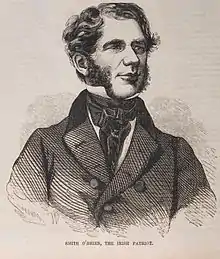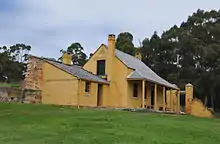William Smith O'Brien
William Smith O'Brien (Irish: Liam Mac Gabhann Ó Briain; 17 October 1803 – 18 June 1864) was an Irish nationalist Member of Parliament (MP) and leader of the Young Ireland movement. He also encouraged the use of the Irish language. He was convicted of sedition for his part in the Young Irelander Rebellion of 1848, but his sentence of death was commuted to deportation to Van Diemen's Land. In 1854, he was released on the condition of exile from Ireland, and he lived in Brussels for two years. In 1856 O'Brien was pardoned and returned to Ireland, but he was never active again in politics.
William Smith O'Brien | |
|---|---|
 William Smith O'Brien | |
| Born | 17 October 1803 |
| Died | 18 June 1864 (aged 60) |
| Resting place | Rathronan Cemetery, Ardagh, County Limerick, Ireland 52.506997°N 9.072535°W |
| Education | Trinity College, Cambridge |
| Known for | Irish nationalist MP, leader of the Young Ireland movement |
Early life
Born in Dromoland, Newmarket on Fergus, County Clare, he was the second son of Sir Edward O'Brien, 4th Baronet, of Dromoland Castle.[1] His mother was Charlotte Smith, whose father owned a property called Cahirmoyle in County Limerick. William took the additional surname Smith, his mother's maiden name, upon inheriting the property. He lived at Cahermoyle House, a mile from Ardagh, County Limerick.[2] He was a descendant of the eleventh century Ard Rí (High King of Ireland), Brian Boru.[3] He received an upper-class English education at Harrow School and Trinity College, Cambridge.[4] Subsequently, he studied law at King's Inns in Dublin and Lincoln's Inn in London.[1]
Politics
.jpg.webp)
From April 1828 to 1831 he was Conservative MP for Ennis. He became MP for Limerick County in 1835, holding his seat in the House of Commons until 1849.[5] Being found guilty of High Treason he forfeited his seat in the House of Commons.
Although a Protestant country-gentleman, he supported Catholic Emancipation while remaining a supporter of British-Irish union. In 1843, in protest against the imprisonment of Daniel O'Connell, he joined O'Connell's anti-union Repeal Association.[5]
Three years later, O'Brien withdrew the Young Irelanders from the association. With Thomas Francis Meagher, in January 1847 he founded the Irish Confederation, although he continued to preach reconciliation until O'Connell's death in May 1847.[5] He was active in seeking relief from the hardships of the famine. In March 1848, he spoke out in favour of a National Guard and tried to incite a national rebellion. He was tried for sedition on 15 May 1848 but was not convicted.[6]
Rebellion and transportation

On 29 July 1848, O'Brien and other Young Irelanders led landlords and tenants in a rising in three counties, with an almost bloodless battle against police at Ballingarry, County Tipperary.[1] In O'Brien's subsequent trial, the jury found him guilty of high treason. He was sentenced to be hanged, drawn, and quartered. Petitions for clemency were signed by 70,000 people in Ireland and 10,000 people in England.[7]

In Dublin on 5 June 1849, the sentences of O'Brien and other members of the Irish Confederation were commuted to transportation for life to Van Diemen's Land (Tasmania in present-day Australia).[8]
O'Brien attempted to escape from Maria Island off Tasmania, but was betrayed by Ellis, captain of the schooner hired for the escape. He was sent to Port Arthur where he met up with John Mitchel, who had been transported before the rebellion. The cottages which O'Brien lived in on Maria Island and Port Arthur have been preserved in their 19th century state as memorials.[9]
Having emigrated to the United States, Ellis was tried by another Young Irelanders leader, Terence MacManus, at a lynch court in San Francisco for the betrayal of O'Brien. He was freed for lack of evidence.[9]
In 1854, after five years in Tasmania, O'Brien was released on the condition he never return to the United Kingdom. He settled in Brussels.[10] In May 1856, he was granted an unconditional pardon and returned to Ireland that July. He contributed to the Nation newspaper, and published the two-volume Principles of Government, or Meditations in Exile in 1856,[11] but played no further part in politics.[10]
In 1864 he visited England and Wales, with the view of rallying his failing health, but no improvement took place, and he died at Bangor, in Wales on 16 June 1864.[8]

Irish language
O'Brien was a founding member of the Ossianic Society, whose aim was further the interests of the Irish language and to publish and translate literature relating to the Fianna.
He wrote to his son Edward from Van Diemen's Land, urging him to learn the Irish language. He himself studied the language and used an Irish-language Bible, and presented to the Royal Irish Academy Irish-language manuscripts he had collected. He enjoyed the respect of Clare poets (the county being largely Irish speaking at the time), and in 1863, on his advice, Irish was introduced into a number of schools there.[12]
Memorial
.JPG.webp)
A statue of William Smith O'Brien stands in O'Connell Street, Dublin. Sculpted in Portland limestone, it was designed by Thomas Farrell and erected in D'Olier Street, Dublin, in 1870. It was moved to its present position in 1929.
In the United States, O'Brien County, Iowa is named after him.[13]
Family
While studying in London O'Brien met Mary Ann Wilton and fathered two children born to her. In Autumn 1832 he married Lucy Caroline Gabbett (1811–1861) of County Limerick. They had five boys and two girls.[8]
The children of William Smith O'Brien and Lucy O'Brien were Edward William (Ned) (1831–1909), William Joseph (1839–1867), Lucy Josephine (1840–1907), Lucius Henry (1842–1913), Robert Donough (1844–1917), Charlotte Grace (1845–1909) and Charles Murrough (1849–1877).[1] The elder daughter Lucy Josephine O'Brien married Rev John Gwynn and their children included writer and MP Stephen Gwynn, Lucy Gwynn who was the first woman registrar of Trinity College, Dublin, and Edward Gwynn who was Provost of Trinity College, Dublin. O'Brien's younger daughter Charlotte Grace O'Brien was a campaigner for the better treatment of Irish emigrants.[14]
William Smith O'Brien's elder brother Lucius O'Brien (1800–1872) was for some time member of parliament for County Clare.
William Smith O'Brien's sister Harriet O'Brien married an Anglican priest but was soon widowed. As Harriet Monsell, she founded the order of Anglican nuns, the Community of St John Baptist, in Clewer, Windsor, in 1851. The gold cross she wore, and which still belongs to the Community, was made with gold panned by her brother during his exile in Australia.
Quotes
- "The new Irish flag would be Orange and Green, and would be known as the Irish tricolor."[15]
- "To find a gaol in one of the lovliest spots formed by Nature in one of her loneliest solitudes creates a revulsion of feeling I cannot describe." November 1849, when first sighting Maria Island.
References
- Davis, Marianne, ed. (1998). The Rebel in His Family: Selected Papers of William Smith O'Brien. Irish Narratives. Cork University Press. ISBN 1-85918-181-3.
- "Estate Record: O'Brien (Cahermoyle)". Landed Estates Database. 18 May 2011. Retrieved 1 November 2013.
- O'Donoghue, John (1860). Historical Memoir of the O'Briens. Dublin: Hodges, Smith & Co (reprinted 2002, Martin Breen). pp. 544–545. ISBN 0-9519551-2-8.
- "O'Brien, William [Smith] (OBRN821WS)". A Cambridge Alumni Database. University of Cambridge.
- Rudé, G., "O'Brien, William Smith (1803–1864)", Australian Dictionary of Biography, National Centre of Biography, Australian National University
- Gwynn, Denis (1949). Young Ireland and 1848. Cork: Cork University Press. pp. 165–187.
- Lawler, Ruth; from originals held by National Archives of Ireland (2001). CD ROM – The 1848 Petitions – The William Smith O'Brien Petition, Irish Records Index Vol. 2. Dublin: Eneclann Ltd. ISBN 0-9537557-2-X.
- "William Smith O'Brien (1803–1864)", Clare People', Clare County Library
- Touhill, Blanche (1981). William Smith O'Brien and His Irish Revolutionary Companions in Penal Exile. Columbia & London: University of Missouri Press. p. 124. ISBN 0-8262-0339-6.
- Article by John Cussen
- Chisholm, Hugh, ed. (1911). . Encyclopædia Britannica. 19 (11th ed.). Cambridge University Press. p. 953.
- Noone, Val (2012). Hidden Ireland in Victoria. Ballarat: Ballarat Heritage Services. pp. 53–54. ISBN 978-1-876478-83-4.
- Chicago and North Western Railway Company (1908). A History of the Origin of the Place Names Connected with the Chicago & North Western and Chicago, St. Paul, Minneapolis & Omaha Railways. p. 162.
- Miller, Chandra. Tumbling Into the Fight, Charlotte Grace O’Brien (1845–1909); The Emigrant’s Advocate, in History Ireland, Vol. 4, Issue 4 (Winter 1996)
- Macdonagh, Michael (1898). Irish Life and Character. London. p. 238. OCLC 810891780.
Further reading
- Smith O'Brien, William (1856). Principles of Government or Meditations in Exile. Dublin & Boston: James Duffy, Patrick Donahoe. Vol. I – 388pp., Vol. II – 380pp. US edition single vol. 480pp.
- Hough, John (1998). William Smith O'Brien: the unlikely revolutionary. [pamphlet].
- Young Ireland and 1848, Dennis Gwynn, Cork University Press 1949.
- Smith O'Brien And The "Secession", Dennis Gwynn,Cork University Press
- The Fenians in Context Irish Politics & Society 1848–82, R. V. Comerford, Wolfhound Press 1998
- William Smith O'Brien and the Young Ireland Rebellion of 1848, Robert Sloan, Four Courts Press 2000
- Young Ireland, T. F. O'Sullivan, The Kerryman Ltd. 1945.
External links
| Wikimedia Commons has media related to William Smith O'Brien. |
 Quotations related to William Smith O'Brien at Wikiquote
Quotations related to William Smith O'Brien at Wikiquote- Hansard 1803–2005: contributions in Parliament by William Smith O'Brien
| Parliament of the United Kingdom | ||
|---|---|---|
| Preceded by Thomas Frankland Lewis |
Member of Parliament for Ennis 1828–1831 |
Succeeded by William Vesey-FitzGerald |
| Preceded by Standish Darby O'Grady |
Member of Parliament for Limerick County 1835–1849 |
Succeeded by Samuel Dickson |